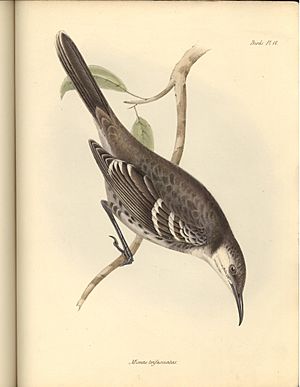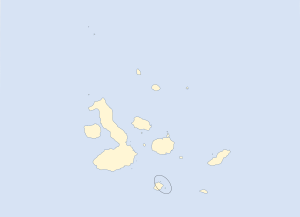Floreana mockingbird facts for kids
Quick facts for kids Floreana mockingbird |
|
|---|---|
 |
|
| Illustration by John Gould (1839) | |
| Conservation status | |
| Scientific classification | |
 |
|
| Synonyms | |
|
The Floreana mockingbird is a special type of bird found only in the Galápagos Islands. It's also called the Charles Island mockingbird. This bird belongs to the family Mimidae, which includes other mockingbirds.
It used to live on Floreana Island. Now, you can only find it on two tiny islands nearby: Campeón and Gardner-near-Floreana. These small islands are off the coast of Floreana.
This bird is sometimes called Darwin's mockingbird. That's because Charles Darwin studied it. He noticed how different these birds were from others. This helped him understand how new species can develop over time.
Contents
About the Floreana Mockingbird
What Kind of Bird Is It?
The Floreana mockingbird is part of a group of mockingbirds. This group includes the Galapagos mockingbird, Espanola mockingbird, and San Cristobal mockingbird. Scientists once thought they were all the same species. Now, they know they are different but closely related. The Floreana mockingbird is unique and doesn't have different types within its own species.
What Does It Look Like?
The Floreana mockingbird is about 25 to 26 centimeters (10 to 10.2 inches) long. Males are a bit heavier than females. Males weigh about 65.7 grams (2.3 ounces). Females weigh around 59.8 grams (2.1 ounces).
Adult birds have a mix of colors. They have a light stripe above their eye. There's a dark patch in front of the eye and a darkish one below it. Their cheeks are white. Their head, back, and tail are grayish-brown. They have some faint darker stripes. Their belly is whitish. There's a dark spot on the side of their chest. They also have faint spots on their chest and sides. When their wings are folded, you can see two white bars. Young birds look similar but have more streaks.
Where Does It Live?
The Floreana mockingbird used to be common on Floreana Island. But by 1888, it had disappeared from there. Now, it lives only on two small islets. These are Campeón and Gardner-near-Floreana.
These islets have low plants along their shores. Inland, there is dry scrubland. You can find cacti and a few trees there. This is the perfect home for these birds.
How the Floreana Mockingbird Lives
What Does It Eat?
The Floreana mockingbird mostly looks for food on the ground. It also finds food in plants. It mainly eats insects. But it also enjoys cactus fruit. Sometimes, it eats dead animals. It probably eats seabird eggs too.
How Does It Raise Its Young?
The Floreana mockingbird breeds from October to April. They usually have two sets of babies during this time. These birds are cooperative breeders. This means up to five adult birds help raise the young. They share a territory of about 2 hectares (5 acres).
Their nest is shaped like a cup. It is made of twigs and lined with softer materials. They almost always build their nests in a cactus. A female bird usually lays two to four eggs.
What Does Its Song Sound Like?
The Floreana mockingbird has a loud and beautiful song. It does not copy the songs of other birds.
Helping the Floreana Mockingbird
Its Status Today
The IUCN (International Union for Conservation of Nature) first listed the Floreana mockingbird as Endangered in 1994. In 2008, its status changed to Critically Endangered. This means it was in very high danger of disappearing. But in 2017, it went back to being Endangered.
It disappeared from Floreana Island by 1888. This happened because of animals brought to the island. These included rats, mice, cats, dogs, and goats. They harmed the mockingbirds or took their food.
The number of birds on the two small islets changes. It depends on events like El Niño. But scientists believe there are more than 250 birds. The population seems to be stable.
Efforts to Bring Them Back
Scientists are working to bring the Floreana mockingbird back to Floreana Island. They are studying the island's habitat. They are also checking on the animals that were brought there. These animals are predators (they hunt the birds) or competitors (they compete for food). These studies will help make the island safe for the mockingbirds again.
See also
 In Spanish: Sinsonte de Floreana para niños
In Spanish: Sinsonte de Floreana para niños


